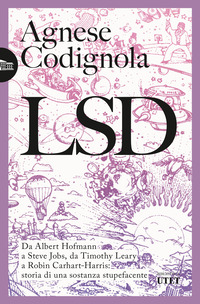LSD. Da Albert Hofmann a Steve Jobs, da Timothy Leary a Robin Carhart-Harris: storia di una sostanza stupefacente
by Codignola, Agnese
April 19, 1943. Albert Hofmann, a chemist working for the pharmaceutical company Sandoz in Basel, gets on his bicycle and heads home. It seems like an ordinary day—except that he has just ingested 250 micrograms of lysergic acid diethylamide-25, a compound he had synthesized in search of a circulatory stimulant. What happens during his ride shatters his perception of reality: visions both wondrous and terrifying, glimpses of parallel worlds, waves of terror and euphoria. LSD is born.
Hofmann immediately recognizes the substance’s potential to disrupt synaptic connections and induce ego dissolution—a complete reset of the self that could help treat trauma, depression, migraines, and addiction. For twenty years, he experiments with LSD and helps spread it within scientific circles, but soon the world beyond also takes notice. As society emerges from the darkness of war, it becomes fascinated by this colorful psychedelic universe—not only Aldous Huxley, with his Doors of Perception, but even Cary Grant, who promotes LSD as a cure for the stress of modern life.
Then, almost inevitably, LSD transforms: from a promising pharmaceutical to a symbol of counterculture, a bridge to Eastern transcendence, from the Beatles’ India to the psychedelic madness of Syd Barrett. In 1971, the UN bans its use and experimentation, marking the end of an era. But not forever—exploiting legal loopholes, underground researchers across the world continue their studies, while LSD’s creative influence shapes the minds of Steve Jobs and the pioneers of Silicon Valley.
From visionary psychoanalysts to eccentric British countesses drilling holes in their skulls, from drugged spiders to neuroscientists conversing with dolphins, Agnese Codignola retraces the astonishing history of LSD—from its origins to today’s psychedelic renaissance. With revolutionary microdosing and groundbreaking research on LSD’s effects on neural connections, the “problem child” of Hofmann is once again at the forefront of official scientific experimentation.
- Publishing house UTET
- Year of publication 2024
- Number of pages 272
- ISBN 9791221213867
- Foreign Rights Maria Luisa Borsarelli, mluisa.borsarelli@deagostinilibri.it
- Price 16.00
Codignola, Agnese
Agnese Codignola graduated in chemistry and pharmaceutical technologies and worked as a researcher at the University of Milan, where she earned a PhD in pharmacology. She later dedicated herself entirely to science communication, becoming a professional journalist. Today, she collaborates with major publishing groups on topics related to health, nutrition, and environmental sustainability. She also gives lectures and participates in podcasts, radio programs, and television broadcasts.






